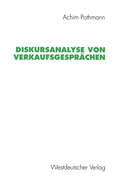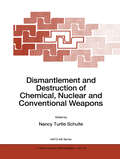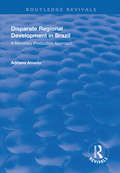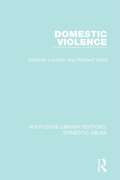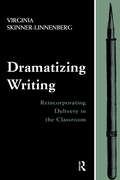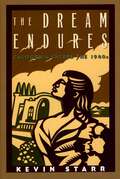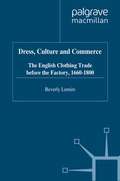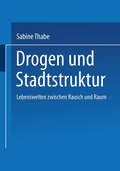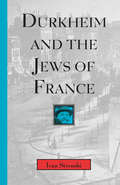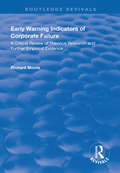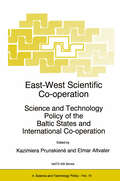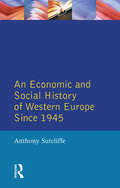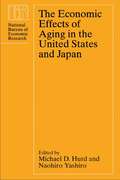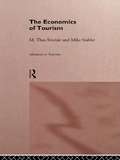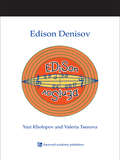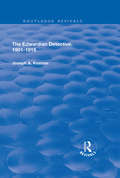- Table View
- List View
Diskursanalyse von Verkaufsgesprächen
by Achim PothmannMehr als eintausend Veröffentlichungen befassen sich schwerpunktmäßig mit der Thematik von Verkaufsgesprächen. Diese Literatur ist geprägt von normativen Tips, Tricks und Ratschlägen für Verkaufsgespräche, die vornehmlich von Praktikern für Verkaufspraktiker propagiert werden. Sprachwissenschaftlich wurde das Verkaufsgespräch bisher nur partiell untersucht. Umfassende linguistische Analyseergebnisse fehlen. Diese Studie stellt eine erste empirisch fundierte Einführung in den Untersuchungsgegenstand "Verkaufsgespräch" aus linguistischer, insbesondere kommunikationsanalytischer Perspektive dar.
Dismantlement and Destruction of Chemical, Nuclear and Conventional Weapons (NATO Science Partnership Subseries: 1 #10)
by N. SchulteThe end ofthe Cold War opened unprecedented opportunities for reductions in weapons of mass destruction. With these opportunities came new challenges, both scientific and political. Traditionally approached by different groups, the scientific, technical and political challenges are inextricably intertwined. Agreements to dismantle and destroy chemical, nuclear and conventional weapons, after having been negotiated via diplomatic channels, require the expertise of scientists associated with their development to determine the safest and most environmentally sound methods of destruction. It is in this context that representatives from sixteen countries and five international organizations were convened jointly by NATO, the Ministry of Foreign Affairs of the Federal Republic of Germany and the State Government of North Rhine Westphalia 19-21 May, 1996 in a meeting near Bonn to take stock of worldwide efforts to destroy and dismantle chemical, nuclear and conventional weapons remaining after the end ofthe Cold War. NATO support was provided under the auspices of the NATO Science Committee's Panel on Disarmament Technologies. The conference brought together the major actors involved in the dismantlement and destruction of chemical, nuclear and conventional weapons, highlighted the substantial accomplishments achieved in this area and pinpointed the remaining technical obstacles still to be overcome. It also underlined the critical importance of transparency, data exchange and verification as indispensable preconditions for disarmament and cooperative security.
Disparate Regional Development in Brazil: A Monetary Production Approach (Routledge Revivals)
by Adriana AmadoPublished in 1997, an analysis of the regional development problem in Brazil from a monetary perspective. The author deals with the vicious circles generated in a country with strong regional disparities, emphasizing the link between real and financial problems. Some elements of dependency theory and of post-Keynesian monetary theory are adopted to create a new model which can cope with both financial and real problems in the same framework. State policies for the regions are also examined and the study finds that they are inadequate in the prevention of the vicious circles which lead to disparate regional growth.
Disparate Regional Development in Brazil: A Monetary Production Approach (Routledge Revivals)
by Adriana AmadoPublished in 1997, an analysis of the regional development problem in Brazil from a monetary perspective. The author deals with the vicious circles generated in a country with strong regional disparities, emphasizing the link between real and financial problems. Some elements of dependency theory and of post-Keynesian monetary theory are adopted to create a new model which can cope with both financial and real problems in the same framework. State policies for the regions are also examined and the study finds that they are inadequate in the prevention of the vicious circles which lead to disparate regional growth.
Domestic Violence (Routledge Library Editions: Domestic Abuse)
by Deborah Lockton Richard WardFirst published in 1997, this book marks a culmination of a three year research programme focused upon the incidence of domestic violence in Leicester. The study examined the levels of violence, the details of applicants and respondents and the nature of complaints, as well as the policies applied and the problems faced by those enforcing the law. The books sets the findings in the context of the policies on protection of victims of domestic violence, the problems they face and protection after 1997. This book will be of interest to those studying law, social work, sociology and women’s studies.
Domestic Violence (Routledge Library Editions: Domestic Abuse)
by Deborah Lockton Richard WardFirst published in 1997, this book marks a culmination of a three year research programme focused upon the incidence of domestic violence in Leicester. The study examined the levels of violence, the details of applicants and respondents and the nature of complaints, as well as the policies applied and the problems faced by those enforcing the law. The books sets the findings in the context of the policies on protection of victims of domestic violence, the problems they face and protection after 1997. This book will be of interest to those studying law, social work, sociology and women’s studies.
Dramatizing Writing: Reincorporating Delivery in the Classroom
by Virginia Skinner-LinnenbergAlthough speech departments have "owned" delivery for the last 100 years, those who teach writing, especially English departments, can gain a great deal by reinstating delivery into their conceptions of and theories about writing. Thus, in the author's vision of "dramatizing writing" in the composition classroom, delivery can have an impact on all the composing steps, from invention to final draft. The goals of this text are to redefine delivery for writing, to reunite it with other parts of the classical rhetorical canon, and to practically apply it in contemporary writing instruction. This text is divided into three main sections. The first provides a survey of the history of delivery in rhetorical theory. A continuum is set up from a totally physical conception of delivery to a noetic one which incorporates more intellectual processes. The argument is that the tension heightened by discord over its definition eventually led to the splitting of delivery from the rhetorical canon. A separate discussion of the women's challenge to delivery is also included. The next section contains a survey of facets of delivery that exist in current theory combined with the author's own theory of delivery. It provides insight into the state of delivery in contemporary writing instruction. The author argues that since the split of delivery from the rhetorical canon has caused a modern bias against delivery in writing theory, many strategies that could aid in the teaching of writing have either been overlooked or undertheorized. Therefore, she borrows from current theoretical areas within and outside of writing in order to construct her own theory of delivery. The last section provides practical applications of delivery in writing instruction. Again borrowing from many sources inside and outside of composition, she describes the techniques teachers may use to incorporate delivery in a writing classroom. Through the use of delivery, more strategies may be developed to aid in the teaching of writing. Special features include: * the incorporation of some practices that had been in use in the composition classroom for many years but did not have any consciously theoretical grounding; * the discussion of women rhetoricians' theories on delivery; * the combination of many contemporary theoretical areas including theatrical, feminist, rhetorical, and pedagogical to form the author's redefined theory of delivery; and * the presentation of practical applications of this new theory of delivery for teachers to utilize in their own classrooms.
Dramatizing Writing: Reincorporating Delivery in the Classroom
by Virginia Skinner-LinnenbergAlthough speech departments have "owned" delivery for the last 100 years, those who teach writing, especially English departments, can gain a great deal by reinstating delivery into their conceptions of and theories about writing. Thus, in the author's vision of "dramatizing writing" in the composition classroom, delivery can have an impact on all the composing steps, from invention to final draft. The goals of this text are to redefine delivery for writing, to reunite it with other parts of the classical rhetorical canon, and to practically apply it in contemporary writing instruction. This text is divided into three main sections. The first provides a survey of the history of delivery in rhetorical theory. A continuum is set up from a totally physical conception of delivery to a noetic one which incorporates more intellectual processes. The argument is that the tension heightened by discord over its definition eventually led to the splitting of delivery from the rhetorical canon. A separate discussion of the women's challenge to delivery is also included. The next section contains a survey of facets of delivery that exist in current theory combined with the author's own theory of delivery. It provides insight into the state of delivery in contemporary writing instruction. The author argues that since the split of delivery from the rhetorical canon has caused a modern bias against delivery in writing theory, many strategies that could aid in the teaching of writing have either been overlooked or undertheorized. Therefore, she borrows from current theoretical areas within and outside of writing in order to construct her own theory of delivery. The last section provides practical applications of delivery in writing instruction. Again borrowing from many sources inside and outside of composition, she describes the techniques teachers may use to incorporate delivery in a writing classroom. Through the use of delivery, more strategies may be developed to aid in the teaching of writing. Special features include: * the incorporation of some practices that had been in use in the composition classroom for many years but did not have any consciously theoretical grounding; * the discussion of women rhetoricians' theories on delivery; * the combination of many contemporary theoretical areas including theatrical, feminist, rhetorical, and pedagogical to form the author's redefined theory of delivery; and * the presentation of practical applications of this new theory of delivery for teachers to utilize in their own classrooms.
The Dream Endures: California Enters the 1940s (Americans and the California Dream)
by Kevin StarrWhat we now call "the good life" first appeared in California during the 1930s. Motels, home trailers, drive-ins, barbecues, beach life and surfing, sports from polo and tennis and golf to mountain climbing and skiing, "sportswear" (a word coined at the time), and sun suits were all a part of the good life--perhaps California's most distinctive influence of the 1930s. In The Dream Endures, Kevin Starr shows how the good life prospered in California--in pursuits such as film, fiction, leisure, and architecture--and helped to define American culture and society then and for years to come. Starr previously chronicled how Californians absorbed the thousand natural shocks of the Great Depression--unemployment, strikes, Communist agitation, reactionary conspiracies--in Endangered Dreams, the fourth volume of his classic history of California. In The Dream Endures, Starr reveals the other side of the picture, examining the newly important places where the good life flourished, like Los Angeles (where Hollywood lived), Palm Springs (where Hollywood vacationed), San Diego (where the Navy went), the California Institute of Technology in Pasadena (where Einstein went and changed his view of the universe), and college towns like Berkeley. We read about the rich urban life of San Francisco and Los Angeles, and in newly important communities like Carmel and San Simeon, the home of William Randolph Hearst, where, each Thursday afternoon, automobiles packed with Hollywood celebrities would arrive from Southern California for the long weekend at Hearst Castle. The 1930s were the heyday of the Hollywood studios, and Starr brilliantly captures Hollywood films and the society that surrounded the studios. Starr offers an astute discussion of the European refugees who arrived in Hollywood during the period: prominent European film actors and artists and the creative refugees who were drawn to Hollywood and Southern California in these years--Igor Stravinsky, Arnold Schoenberg, Man Ray, Bertolt Brecht, Christopher Isherwood, Aldous Huxley, Thomas Mann, and Franz Werfel. Starr gives a fascinating account of how many of them attempted to recreate their European world in California and how others, like Samuel Goldwyn, provided stories and dreams for their adopted nation. Starr reserves his greatest attention and most memorable writing for San Francisco. For Starr, despite the city's beauty and commercial importance, San Francisco's most important achievement was the sense of well-being it conferred on its citizens. It was a city that "magically belonged to everyone." Whether discussing photographers like Edward Weston and Ansel Adams, "hard-boiled fiction" writers, or the new breed of female star--Marlene Dietrich, Jean Harlow, Bette Davis, Carole Lombard, and the improbable Mae West--The Dream Endures is a brilliant social and cultural history--in many ways the most far-reaching and important of Starr's California books.
Dress, Culture and Commerce: The English Clothing Trade before the Factory, 1660–1800
by B. LemireThis work examines a trade that covered the backs of sailors and soldiers, that shirted labouring men and skirted working women, that employed legions of needlewomen and supplied retailers with new consumer wares. Garments, once bought, returned again to the marketplace, circulating like a currency and bolstering demand. The agents in this trade included military contractors for clothing, female outworkers and dealers in used clothes. Each was affected by a changing demand for new-styled 'luxuries' and necessities in apparel.
Durkheim and the Jews of France (Chicago Studies in the History of Judaism #1997)
by Ivan StrenskiIvan Strenski debunks the common notion that there is anything "essentially" Jewish in Durkheim's work. Seeking the Durkheim inside the real world of Jews in France rather than the imagined Jewishness inside Durkheim himself, Strenski adopts a Durkheimian approach to understanding Durkheim's thought. In so doing he shows for the first time that Durkheim's sociology (especially his sociology of religion) took form in relation to the Jewish intellectual life of late nineteenth- and early twentieth-century France. Strenski begins each chapter by weighing particular claims (some anti-Semitic, some not) for the Jewishness of Durkheim's work. In each case Strenski overturns the claim while showing that it can nonetheless open up a fruitful inquiry into the relation of Durkheim to French Jewry. For example, Strenski shows that Durkheim's celebration of ritual had no innately Jewish source but derived crucially from work on Hinduism by the Jewish Indologist Sylvain Lévi, whose influence on Durkheim and his followers has never before been acknowledged.
Durkheim and the Jews of France (Chicago Studies in the History of Judaism #1997)
by Ivan StrenskiIvan Strenski debunks the common notion that there is anything "essentially" Jewish in Durkheim's work. Seeking the Durkheim inside the real world of Jews in France rather than the imagined Jewishness inside Durkheim himself, Strenski adopts a Durkheimian approach to understanding Durkheim's thought. In so doing he shows for the first time that Durkheim's sociology (especially his sociology of religion) took form in relation to the Jewish intellectual life of late nineteenth- and early twentieth-century France. Strenski begins each chapter by weighing particular claims (some anti-Semitic, some not) for the Jewishness of Durkheim's work. In each case Strenski overturns the claim while showing that it can nonetheless open up a fruitful inquiry into the relation of Durkheim to French Jewry. For example, Strenski shows that Durkheim's celebration of ritual had no innately Jewish source but derived crucially from work on Hinduism by the Jewish Indologist Sylvain Lévi, whose influence on Durkheim and his followers has never before been acknowledged.
Durkheim and the Jews of France (Chicago Studies in the History of Judaism #1997)
by Ivan StrenskiIvan Strenski debunks the common notion that there is anything "essentially" Jewish in Durkheim's work. Seeking the Durkheim inside the real world of Jews in France rather than the imagined Jewishness inside Durkheim himself, Strenski adopts a Durkheimian approach to understanding Durkheim's thought. In so doing he shows for the first time that Durkheim's sociology (especially his sociology of religion) took form in relation to the Jewish intellectual life of late nineteenth- and early twentieth-century France. Strenski begins each chapter by weighing particular claims (some anti-Semitic, some not) for the Jewishness of Durkheim's work. In each case Strenski overturns the claim while showing that it can nonetheless open up a fruitful inquiry into the relation of Durkheim to French Jewry. For example, Strenski shows that Durkheim's celebration of ritual had no innately Jewish source but derived crucially from work on Hinduism by the Jewish Indologist Sylvain Lévi, whose influence on Durkheim and his followers has never before been acknowledged.
Early Warning Indicators of Corporate Failure: A Critical Review of Previous Research and Further Empirical Evidence (Routledge Revivals)
by Richard MorrisPublished in 1997, this text focuses on the conundrum between the academics ability to distinguish between failing and non-failing businesses with models of over 85.5per cent accuracy, and the reasons why credit agencies and the like do not act on such information. The author asks, are the models defective?
Early Warning Indicators of Corporate Failure: A Critical Review of Previous Research and Further Empirical Evidence (Routledge Revivals)
by Richard MorrisPublished in 1997, this text focuses on the conundrum between the academics ability to distinguish between failing and non-failing businesses with models of over 85.5per cent accuracy, and the reasons why credit agencies and the like do not act on such information. The author asks, are the models defective?
East-West Scientific Co-operation: Science and Technology Policy of the Baltic States and International Co-operation (NATO Science Partnership Subseries: 4 #15)
by Kazimiera PrunskienėAll former Soviet Union countries experience their past as a heavy burden. It led to the centralisation of scientific personnel, the separation of research from teaching at universities, and a concentration of certain branches of technology in different parts of the Union. This has given rise to a one-sided technology and science potential which frequently cannot be sufficiently supported due to a lack of adequate finance. Cooperation between the Baltic States themselves is often hampered by an exaggerated sense of national identity, and international cooperation can be made difficult by linguistic problems. A critical issue is finance. The Baltic States themselves are experiencing budgetary constraints, and the West is cutting back on funding. The analytical issues dealt with here include specific questions, such as in the sectors of energy policy, electrical equipment and electronics, and environmental considerations. The transfer of technology is also discussed, as is security: there is the possibility that science and scientific results can be obtained from the former Soviet Union at low cost by the criminal community.
Economic and Social History of Western Europe since 1945, An
by Anthony SutcliffeThis is the ideal companion text to A Political History of Western Europe Since 1945. It is an introductory survey which explains how western Europe built up its postwar prosperity and is moving towards continental integration. Themes treated include: the origins of the EC; consumerism; youth culture and protest; immigration; the oil crisis and its aftermath; and the contrasting experience and expectations of the Nordic world and the Mediterranean south. The book ends with the consequences of Soviet collapse. Designed for general history students, it assumes no formal knowledge of economics, and is notably accessible and user-friendly in its approach.
Economic and Social History of Western Europe since 1945, An
by Anthony SutcliffeThis is the ideal companion text to A Political History of Western Europe Since 1945. It is an introductory survey which explains how western Europe built up its postwar prosperity and is moving towards continental integration. Themes treated include: the origins of the EC; consumerism; youth culture and protest; immigration; the oil crisis and its aftermath; and the contrasting experience and expectations of the Nordic world and the Mediterranean south. The book ends with the consequences of Soviet collapse. Designed for general history students, it assumes no formal knowledge of economics, and is notably accessible and user-friendly in its approach.
The Economic Effects of Aging in the United States and Japan (National Bureau of Economic Research Project Report)
by Michael D. Hurd Naohiro YashiroDue to falling fertility rates, the aging of the baby-boom cohort, and increases in life expectancy, the percentage of the population that is elderly is expected to increase rapidly in the United States and Japan over the next two decades. These fourteen essays show that, despite differences in culture and social and government structure, population aging will have many similar macro and micro effects on the economic status and behavior of the elderly in both countries. The most obvious effects will be on social programs such as public pension systems and the provision for medical needs of the elderly. But, the contributors demonstrate, aging will also affect markets for labor, capital, housing, and health care services. It will affect firms through their participation in the demand side of the labor market and through their provisions for pensions. And aging will influence saving rates, the rate of return on assets, the balance of payments, and, most likely, economic growth. This volume will interest scholars and policy makers concerned with the economics of aging.
The Economics of Tourism
by M. Thea Sinclair Mike StablerMakes a key contribution from an economic standpoint to the understanding of tourism. Examining such issues as how tourism firms operate in national and global contexts, the effects of tourism on destination areas, the demand for tourism, and the interaction between tourism and natural environments, this comprehensive introduction explains how econ
The Economics of Tourism (Routledge Advances In Tourism Ser.)
by M. Thea Sinclair Mike StablerMakes a key contribution from an economic standpoint to the understanding of tourism. Examining such issues as how tourism firms operate in national and global contexts, the effects of tourism on destination areas, the demand for tourism, and the interaction between tourism and natural environments, this comprehensive introduction explains how econ
Edison Denisov
by KholopovFirst published in 1997. Routledge is an imprint of Taylor & Francis, an informa company.
Edison Denisov
by KholopovFirst published in 1997. Routledge is an imprint of Taylor & Francis, an informa company.
The Edwardian Detective: 1901-15 (Routledge Revivals)
by Professor Joseph KestnerThis title was first published in 1999 & examines the range of detective literature produced between 1901 and 1915 in Britain, during the reign of Edward VII and the early reign of George V. The book assesses the literature as cultural history, with a focus on issues such as legal reform, marital reform, surveillance, Germanophobia, masculinity/femininity, the "best-seller", the arms race, international diplomacy and the concept of "popular" literature. The work also addresses specific issues related to the relationship of law to literature, such as: the law in literature; the law as literature, the role of literature in surveillance and policing; the interpretation of legal issues by literature; the degree to which literature describes and interprets law; the description of legal processes in detective literature; and the connections between detective literature and cultural practices and transitions.
